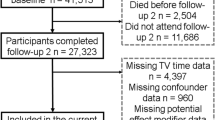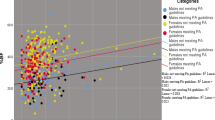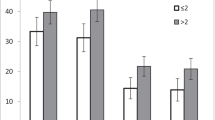Abstract
BACKGROUND: Obesity is epidemic in the U.S. and has been associated with television viewing.
OBJECTIVE: To describe the association between obesity and television viewing practices among women veterans.
DESIGN, SETTING AND PARTICIPANTS: Cross-sectional, mailed survey completed by 1,555 female veterans enrolled at the VA Puget Sound Health Care System in 2000.
MEASUREMENTS AND METHODS: We used bivariate and multivariate analyses to assess the association of obesity (body mass index >30 kg/m2 based on self-reported height and weight) with self-reported number of hours of television or videos viewed per day, and frequency of eating meals or snacking while watching television, controlling for other covariates.
RESULTS: Watching television >2 hours per typical day on week days and/or weekends was associated with obesity (P<.001), as was eating or snacking while watching television (P=.003). In multivariate logistic regression analyses, watching television >2 hours per day and eating or snacking while watching television were each associated with obesity (odds ratio [OR] 1.4, 95% confidence interval [CI] 1.1 to 1.8; and OR 1.3, 95% CI 1.0 to 1.7, respectively), after adjusting for demographic variables, smoking, physical activity, and depression. Results were similar when posttraumatic stress disorder was included in the model instead of depression. Women who both watched >2 hours of television per day and ate or snacked while viewing were almost twice as likely to be obese (OR 1.9, 95% CI 1.4 to 2.6).
CONCLUSION: Watching television over 2 hours per day and eating while watching television were each associated with obesity among female VA patients and may be modifiable risk factors for obesity.
Similar content being viewed by others
References
Hedley AA, Ogden CL, Johnson CL, Carroll MD, Curtin LR, Flegal KM. Prevalence of overweight and obesity among US children, adolescents, and adults, 1999–2002. JAMA. 2004;291:2847–50.
Bray GA. Medical consequences of obesity. J Clin Endocrinol Metab. 2004;89:2583–9.
Healthy People 2010. 2005. Office of Disease Prevention and Health Promotion, U.S. Department of Health and Human Services; 2005. Available at: http://www.healthypeople.gov/. Accessed July 21, 2005.
Cummings DE, Schwartz MW. Genetics and pathophysiology of human obesity. Ann Rev Med. 2003;54:453–71.
Fletcher GF, Blair SN, Blumenthal J, et al. Statement on exercise. Benefits and recommendations for physical activity programs for all Americans. A statement for health professionals by the Committee on Exercise and Cardiac Rehabilitation of the Council on Clinical Cardiology, American Heart association. Circulation. 1992;86:340–4.
Prevalence of leisure-time and occupational physical activity among employed adults—United States, 1990. Morb Mortal Wkly Rep. 2000;49:420–4.
Physical activity and cardiovascular health. NIH Consensus Development Panel on physical activity and cardiovascular health. JAMA. 1996;276:241–6.
Nielsen Report on Television. New York: Nielsen Media Research; 2003.
Papazian E. TV Dimensions. New York: Media Dynamics Inc.; 2003.
Tucker LA, Bagwell M. Television viewing and obesity in adult females. Am J Public Health. 1991;81:908–11.
Ching PL, Willett WC, Rimm EB, Colditz GA, Gortmaker SL, Stampfer MJ. Activity level and risk of overweight in male health professionals. Am J Public Health. 1996;86:25–30.
Sidney S, Sternfeld B, Haskell WL, Jacobs DR Jr., Chesney MA, Hulley SB. Television viewing and cardiovascular risk factors in young adults: the CARDIA study. Ann Epidemiol. 1996;6:154–9.
Cameron AJ, Welborn TA, Zimmet PZ, et al. Overweight and obesity in Australia: the 1999–2000 Australian Diabetes, Obesity and Lifestyle Study (AusDiab). Med J Aust. 2003;178:427–32.
Jeffery RW, French SA. Epidemic obesity in the United States: are fast foods and television viewing contributing? Am J Public Health. 1998;88:277–80.
Robinson TN. Reducing children’s television viewing to prevent obesity: a randomized controlled trial. JAMA. 1999;282:1561–7.
Robinson TN. Television viewing and childhood obesity. Pediatr Clin North Am. 2001;48:1017–25.
Ainsworth BE, Haskell WL, Leon AS, et al. Compendium of physical activities: classification of energy costs of human physical activities. Med Sci Sports Exerc. 1993;25:71–80.
Gore SA, Foster JA, DiLillo VG, Kirk K, Smith West D. Television viewing and snacking. Eat Behav. 2003;4:399–405.
Dietz WH Jr., Gortmaker SL. Do we fatten our children at the television set? Obesity and television viewing in children and adolescents. Pediatrics. 1985;75:807–12.
Dittmar ML. Relations among depression, gender, and television viewing of college students. J Soc Behav Personal. 1994;9:317–28.
Voelkl JE, Fries BE, Galecki AT. Predictors of nursing home residents’ participation in activity programs. Gerontologist. 1995;35:44–51.
Onyike CU, Crum RM, Lee HB, Lyketsos CG, Eaton WW. Is obesity associated with major depression? Results from the Third National Health and Nutrition Examination Survey. Am J Epidemiol. 2003;158:1139–47.
Carpenter KM, Hasin DS, Allison DB, Faith MS. Relationships between obesity and DSM-IV major depressive disorder, suicide ideation, and suicide attempts: results from a general population study. Am J Public Health. 2000;90:251–7.
Dobie DJ, Kivlahan DR, Maynard C, Bush KR, Davis TM, Bradley KA. Posttraumatic stress disorder in female veterans: association with self-reported health problems and functional impairment. Arch Intern Med. 2004;164:394–400.
Frayne SM, Seaver MR, Loveland S, et al. Burden of medical illness in women with depression and posttraumatic stress disorder. Arch Intern Med. 2004;164:1306–12.
Kazis LE, Miller DR, Clark J, et al. Health-related quality of life in patients served by the Department of Veterans Affairs: results from the Veterans Health Study. Arch Intern Med. 1998;158:626–32.
Dobie DJ, Maynard CB, Kivalahan DR, et al. PTSD screening status is associated with increased VA medical and surgical utilization in women. J Gen Intern Med. 2006;21(suppl 3):S58-S64.
Executive summary of the clinical guidelines on the identification, evaluation, and treatment of overweight and obesity in adults. Arch Intern Med. 1998;158:1855–67.
Paeratakul S, White MA, Williamson DA, Ryan DH, Bray GA. Sex, race/ethnicity, socioeconomic status, and BMI in relation to self-perception of overweight. Obes Res. 2002;10:345–50.
(US Department of Health and Human Services, Centers for Disease Control and Prevention National Center for Chronic Disease Prevention and Health Promotion. Physical activity and health: a report of the Surgeon General. 1996
Berwick DM, Murphy JM, Goldman PA, Ware JE Jr., Barsky AJ, Weinstein MC. Performance of a five-item mental health screening test. Med Care. 1991;29:169–76.
Dobie DJ, Kivlahan DR, Maynard C, et al. Screening for post-traumatic stress disorder in female Veteran’s Affairs patients: validation of the PTSD checklist. Gen Hosp Psychiatry. 2002;24:367–74.
Wardle J, Waller J, Jarvis MJ. Sex differences in the association of socioeconomic status with obesity. Am J Public Health. 2002;92:1299–304.
Burke GL, Savage PJ, Manolio TA, et al. Correlates of obesity in young black and white women: the CARDIA Study. Am J Public Health. 1992;82:1621–5.
Gutschoven K, Van den Bulck J. Television viewing and smoking volume in adolescent smokers: a cross-sectional study. Prev Med. 2004;39:1093–8.
Hancox RJ, Milne BJ, Poulton R. Association between child and adolescent television viewing and adult health: a longitudinal birth cohort study. Lancet 2004;364:257–62.
Bradley KA, Bush KR, Davis TM, et al. Binge drinking among female Veterans Affairs patients: prevalence and associated risks. Psychol Addict Behav. 2001;15:297–305.
Author information
Authors and Affiliations
Corresponding author
Additional information
The authors have no conflicts of interest to declare.
The views expressed in this article are those of the authors and do not necessarily represent the views of the Department of Veterans Affairs, the University of Washington, the NIAAA, or the RWJ Foundation. This project was supported by the Department of Veterans Affairs, Veterans Health Administration, and the Health Services Research and Development Service (SDR GEN 97-022). Dr. Bradley was supported by National Institute on Alcohol Abuse and Alcoholism (NIAAA #K23AA00313) and was a Robert Wood Johnson (R.W.J.) Foundation Generalist Physician Faculty Scholar at the time this work was completed. We thank all the women veterans who participated in this study. We also thank Marguerite McNeely, MD, MPH, for her help with development of our survey questions, Kristin R. Bush, MPH, Jennifer L. Sporleder, and Amee J. Epler for assistance with data collection and management, Karen Foster, MD, for review of the manuscript, and Jackie Kimball and Scott Campbell for assistance with manuscript preparation.
Rights and permissions
About this article
Cite this article
Johnson, K.M., Nelson, K.M. & Bradley, K.A. Television viewing practices and obesity among women veterans. J GEN INTERN MED 21 (Suppl 3), S76–S81 (2006). https://doi.org/10.1111/j.1525-1497.2006.00379.x
Published:
Issue Date:
DOI: https://doi.org/10.1111/j.1525-1497.2006.00379.x




